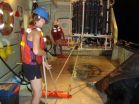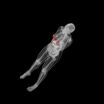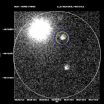(Press-News.org) LA JOLLA, CA—June 4, 2014— Hemorrhagic fevers caused by Lassa, dengue and other viruses affect more than one million people annually and are often fatal, yet scientists have never understood why only some virus-infected people come down with the disease and others do not.
But now, virologists and immunologists at The Scripps Research Institute (TSRI) have found a major clue to the mystery of "hemorrhagic fever" syndromes. In findings reported this week in an Early Edition of the Proceedings of the National Academy of Sciences, the team showed that Interferon Type I (IFN-I) immune proteins are key drivers of a viral syndrome in mice that closely mimics these human hemorrhagic fevers.
"Blocking IFN-I signaling in certain genetic mouse strains completely prevented disease signs such as vascular leakage leading to death," said TSRI Associate Professor of Immunology Roberto Baccala, who, with TSRI Professor Michael Oldstone, led this study.
While IFN-I proteins traditionally have been considered essential for an effective antiviral response and are still used to treat some chronic viral infections, the new study suggests that these proteins sometimes do much more harm than good—and that blocking them, or specific biological pathways they activate, might be a good therapeutic strategy against hemorrhagic fevers.
Striking Impact
The discovery arose from the team's recent research with the New Zealand Black (NZB) mouse, an inbred laboratory strain whose overactive immune system leads, in midlife, to an autoimmune condition resembling lupus. Curious to see how a viral infection in early life would affect the mice, the team injected a group of the animals with a much-studied mouse virus called lymphocytic choriomeningitis virus (LCMV).
The parental LCMV Armstrong (Clone 53b) caused no symptoms and was quickly cleared by the NZB mice. But a variant (clone 13) that is efficient at infecting cells and causing a persistent infection—yet still causes only mild disease in most other mouse strains—had a strikingly different impact, showing serious signs of illness. Seven to eight days after infection, all the NZB mice that been injected with clone 13 had died.
Further examination revealed leaky blood vessels, fluid and immune virus-specific T cell infiltration into the lungs, decreased platelet counts and other pathological signs reminiscent of human hemorrhagic fevers.
As the scientists knew, LCMV is a member of the family of viruses that includes Lassa virus, which causes one of world's most common hemorrhagic fevers—with a high fatality rate—in a subset of infected patients. "Lassa virus and LCMV infect the same cell type via the same cell-surface receptor," Baccala said. Lassa virus infects hundreds of thousands of individuals annually, culminating in more than 20,000 deaths per year.
Most people infected with Lassa virus experience only mild illness, yet about 20 percent develop the hemorrhagic syndrome. Dengue virus manifests similarly, causing a hemorrhagic syndrome in only a subset of patients. The pathology seen in the LCMV clone 13-infected NZB mice suggested that they could serve as useful models of these human hemorrhagic syndromes, providing clues to how they develop and therapeutic stop-points for their treatment.
A New Target
Baccala and his colleagues soon found evidence that the hyperactivity of the NZB mouse antiviral CD8 cytotoxic T cell response is chiefly to blame for its fatal hemorrhagic disease. The researchers observed powerful CD8+ T cells in higher than normal numbers in affected NZB mouse tissues and a greater number of immune-stimulating molecules on the CD8+ cells' surfaces. This CD8+ T cell overreaction damaged the endothelial cells that line pulmonary blood vessels, causing them to become leaky, which in turn led to the fatal buildup of fluid in the lungs.
IFN-I proteins historically have been known as the chief mobilizers of the protective antiviral response. When Baccala and his colleagues blocked IFN-I signaling, up to a day after infection, the CD8+ T cell response was virtually absent, and levels of clone 13 LCMV rose sharply in the NZB mice. Under these conditions, the mice showed no sign of disease and seemed able to tolerate the high viral load indefinitely—implying that the virus itself is virtually harmless when it doesn't prompt an immune reaction.
"We are now working to determine whether we can target IFN-I itself to treat such conditions or whether we need to target the more specific signals, downstream of IFN-I, that cause pathology," said Baccala.
INFORMATION:
In addition to Baccala and Oldstone, the co-authors of the study, "Type I interferon is a therapeutic target for virus-induced lethal vascular damage," were Megan J. Welch, Rosana Gonzalez-Quintial, Kevin B. Walsh, John R. Teijaro, Anthony Nguyen, Cherie T. Ng, Brian Martin Sullivan, Alessandro Zarpellon, Zaverio M. Ruggeri, Juan Carlos de la Torre and Argyrios N. Theofilopoulos, all of TSRI. For more information on the paper, see http://www.pnas.org/content/early/2014/05/29/1408148111.abstract
The study was supported by the National Institutes of Health (grants AI099699, AI009484, CA127535, AR53228, AI077719 and HL42846).
Hemorrhagic fevers can be caused by body's antiviral interferon response
2014-06-04
ELSE PRESS RELEASES FROM THIS DATE:
Astronomers discover first Thorne-Zytkow object, a bizarre type of hybrid star
2014-06-04
In a discovery decades in the making, scientists have detected the first of a "theoretical" class of stars first proposed in 1975 by physicist Kip Thorne and astronomer Anna Żytkow. Thorne-Żytkow objects (TŻOs) are hybrids of red supergiant and neutron stars that superficially resemble normal red supergiants, such as Betelguese in the constellation Orion. They differ, however, in their distinct chemical signatures that result from unique activity in their stellar interiors.
TŻOs are thought to be formed by the interaction of two massive stars―a ...
How red tide knocks out its competition
2014-06-04
New research reveals how the algae behind red tide thoroughly disables – but doesn't kill – other species of algae. The study shows how chemical signaling between algae can trigger big changes in the marine ecosystem.
Marine algae fight other species of algae for nutrients and light, and, ultimately, survival. The algae that cause red tides, the algal blooms that color blue ocean waters red, carry an arsenal of molecules that disable some other algae. The incapacitated algae don't necessarily die, but their growth grinds to a halt. This could explain part of why blooms ...
New diagnostic imaging techniques deemed safe in simulations
2014-06-04
DURHAM, N.C. -- Gamma and neutron imaging offer possible improvements over existing techniques such as X-ray or CT, but their safety is not yet fully understood. Using computer simulations, imaging the liver and breast with gamma or neutron radiation was found to be safe, delivering levels of radiation on par with conventional medical imaging, according to researchers at Duke Medicine.
The findings, published in the June issue of the journal Medical Physics, will help researchers to move testing of gamma and neutron imaging into animals and later humans.
Conventional ...
Study: When hospital workers get vaccines, community flu rates fall
2014-06-04
Anaheim, Calif., June 4, 2014 – For every 15 healthcare providers who receive the influenza vaccination, one fewer person in the community will contract an influenza-like illness, according to a study using California public health data from 2009 – 2012.
In an abstract that will be presented on June 7 at the 41st Annual Conference of the Association for Professionals in Infection Control and Epidemiology (APIC), a researcher analyzed archival data from the California Department of Public Health to determine the relationship between vaccinating healthcare personnel against ...
MU scientists successfully transplant, grow stem cells in pigs
2014-06-04
COLUMBIA, Mo. – One of the biggest challenges for medical researchers studying the effectiveness of stem cell therapies is that transplants or grafts of cells are often rejected by the hosts. This rejection can render experiments useless, making research into potentially life-saving treatments a long and difficult process. Now, researchers at the University of Missouri have shown that a new line of genetically modified pigs will host transplanted cells without the risk of rejection.
"The rejection of transplants and grafts by host bodies is a huge hurdle for medical researchers," ...
Saturated fat intake may influence a person's expression of genetic obesity risk
2014-06-04
Boston, MA (June 4, 2014) ─ Limiting saturated fat could help people whose genetic make-up increases their chance of being obese. In a new study, researchers from the Jean Mayer USDA Human Nutrition Research Center on Aging (USDA HNRCA) at Tufts University identified 63 gene variants related to obesity and used them to calculate a genetic risk score for obesity for more than 2,800 white, American men and women enrolled in two large studies on heart disease prevention. People with a higher genetic risk score, who also consumed more of their calories as saturated fat, ...
Ice cream sensations on the computer
2014-06-04
Changes in coldness, creaminess or texture that we experience in the mouth while we are eating an ice cream can be visualised on a screen using coloured curves. Graphs help manufacturers improve product quality, as proven by researchers at the Institute of Agrochemistry and Food Technology in Valencia, Spain.
In the last five years a technique known as 'Temporal Dominance of Sensations' (TDS) has become popular, used to analyse how consumer impressions evolve from the moment they taste a product.
Researchers at the Institute of Agrochemistry and Food Technology (CSIC) ...
Weight loss surgery also safeguards obese people against cancer
2014-06-04
Weight loss surgery might have more value than simply helping morbidly obese people to shed unhealthy extra pounds. It reduces their risk of cancer to rates almost similar to those of people of normal weight. This is the conclusion of the first comprehensive review article taking into account relevant studies about obesity, cancer rates and a weight loss procedure called bariatric surgery. Published in Springer's journal Obesity Surgery, the review was led by Daniela Casagrande of the Universidade Federal do Rio Grande do Sul in Brazil.
With bariatric surgery, a part ...
Observed by Texas telescope: Light from huge explosion 12 billion years ago reaches Earth
2014-06-04
Intense light from the enormous explosion of a star more than 12 billion years ago — shortly after the Big Bang — recently reached Earth and was visible in the sky.
Known as a gamma-ray burst, light from the rare, high-energy explosion traveled for 12.1 billion years before it was detected and observed by a telescope owned by Southern Methodist University, Dallas.
Gamma-ray bursts are believed to be the catastrophic collapse of a star at the end of its life. SMU physicists report that their telescope was the first on the ground to observe the burst and to capture an ...
A new approach to diversity research
2014-06-04
When people work in socially homogeneous groups, they overestimate their own contributions to the group's success, according to a new study co-authored by an MIT scholar. In fact, in some cases such "self-serving bias" occurs to a degree about five times as great in homogeneous groups as in ethnically diverse groups.
Such results raise a larger point, suggests Evan Apfelbaum, the W. Maurice Young Assistant Professor of Organization Studies at the MIT Sloan School of Management, and the lead author of the new study: Researchers have often used homogeneous social groups ...





